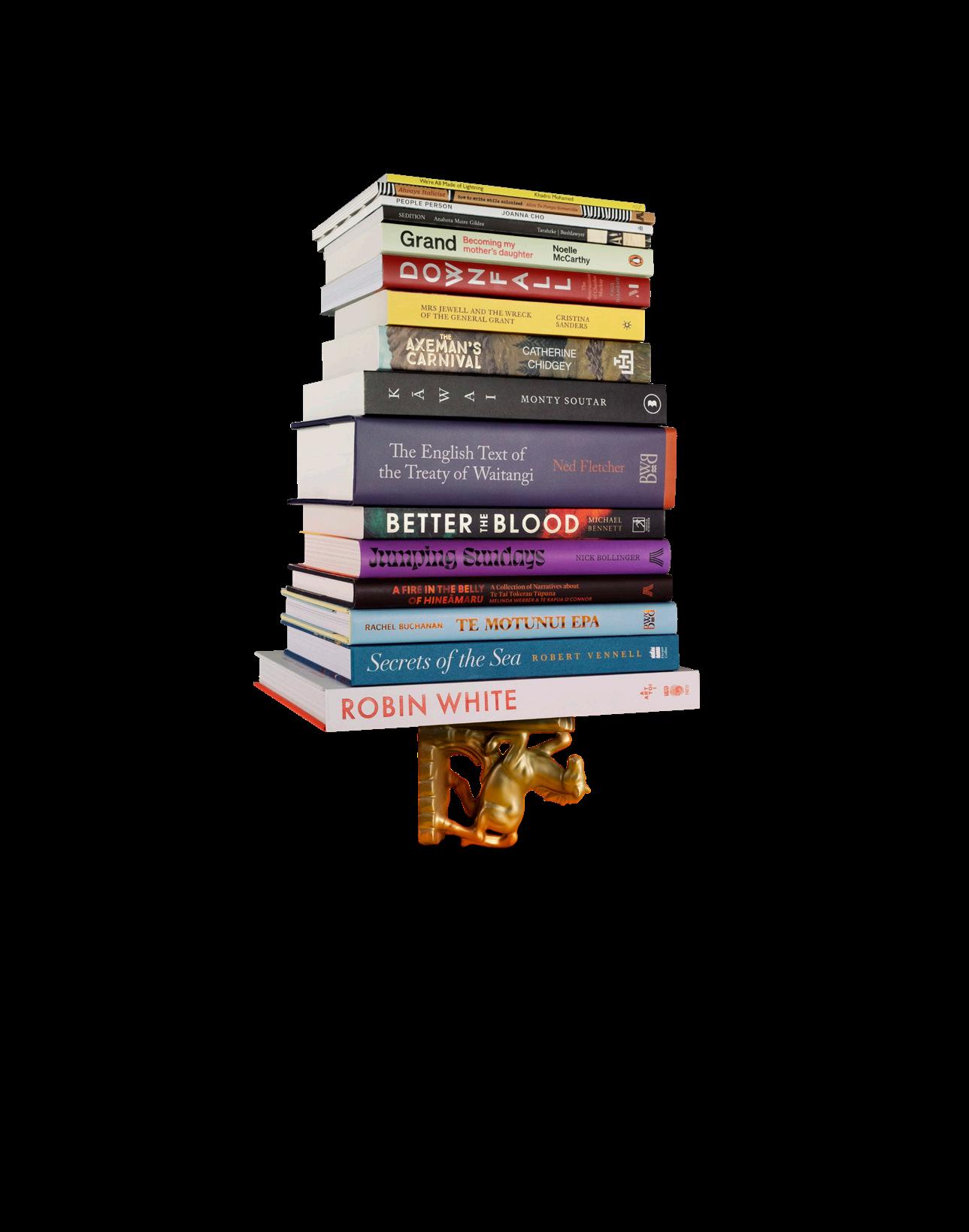Ockhams Sampler
Extracts from the finalist books in the Booksellers Aotearoa New Zealand
Award for Illustrated Non-Fiction at the 2023 Ockham New Zealand
Book Awards

Extracts from the finalist books in the Booksellers Aotearoa New Zealand
Award for Illustrated Non-Fiction at the 2023 Ockham New Zealand
Book Awards
The Booksellers Aotearoa New Zealand Award for Illustrated Non-Fiction at the Ockham New Zealand Book Awards recognises excellence in works — by one or more authors — with combined strength of illustration and text. Prize money in this category is $12,000.

The Illustrated Non-Fiction category in 2023 is judged by award-winning writer, historian and archivist Jared Davidson (convenor); writer and curator Dr Anna-Marie White (Te Ātiawa); and veteran television producer Taualeo’o Stephen Stehlin MNZM.
The judges say the innovative design and compelling storytelling found in this year’s shortlist have redefined what an illustrated non-fiction work can be. “Zine-like textures on uncoated stock, elegant typography across space and time, treasure-troves of littoral illustrations and taonga tuku iho that give voice to their travels are signs of a confident moment in book production. Nothing is pretty-for-pretty’s sake: visual excellence amplifies the immensely relevant and engaging content of these original books.”
This Ockhams Sampler gives you a taste of the craft at play in each of this year’s illustrated non-fiction shortlisted books. You can read the judges’ comments about each finalist in orange at the start of that title’s extract.
Look out for samplers of the finalists in the other three categories in the Ockham New Zealand Book Awards. As they are rolled out in the coming weeks, you will find them here:
www.issuu.com/nzbookawards
www.anzliterature.com
https://www.nzbookawards.nz/new-zealand-book-awards/resources/
JUMPING SUNDAYS: THE RISE AND FALL OF THE COUNTERCULTURE IN AOTEAROA NEW ZEALAND
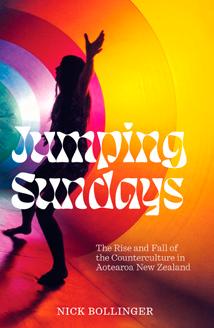
Nick Bollinger
Published by Auckland University Press
ROBIN WHITE: SOMETHING IS HAPPENING HERE

Edited by Sarah Farrar, Jill Trevelyan and Nina Tonga
Published by Te Papa Press and Auckland Art Gallery Toi o Tāmaki

SECRETS OF THE SEA: THE STORY OF NEW ZEALAND’S NATIVE SEA CREATURES
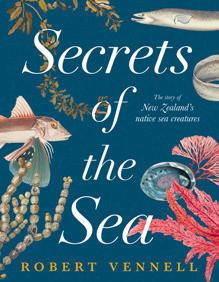
Robert Vennell
Published by HarperCollins
TE MOTUNUI EPA
Rachel Buchanan
Published by Bridget Williams Books

JUDGES’ COMMENTS
With its distinctive cover, bold typography and risograph hues on uncoated stock, this book demands to be read from page one. Weaving original sources into an engaging narrative, Nick Bollinger has crafted a considered and fitting history. Photographs from private collections add to its rich production, balancing text and illustration in ways that belie its size. Like the period it surveys, Jumping Sundays is a game-changer.

On a Sunday afternoon in the spring of 1969, thousands of people defied Auckland city bylaws and came to party in Albert Park. A rock band played on the rotunda. Some people held hands, some danced alone, some sat under trees with guitars, flutes and bongos and made music of their own. They wore kaftans, ponchos and leather-fringed jerkins, floppy hats, headbands, beads and flowers. Poetry and political diatribes were delivered from a podium, improvised from an upturned tea chest. There were bikies, balloons, bubbles, sack races and a lolly scramble, lots of dogs and a pet possum. Someone brought a canoe and paddled it around the fountain, until it capsized. As the afternoon wore on there were joss sticks, skyrockets and what some will have recognised as the musky smell of marijuana.
It wasn’t the first gathering of this kind in New Zealand, but it was, up to this point, easily the biggest. Here, on a seemingly vast scale, people who had been variously labelled as hippies, freaks, weirdies, radicals and dropouts were able to see and celebrate with a great many others who looked and acted a lot like they did. For those watching from the sidelines or looking at newspaper photos in the days that followed, the effect was quite the opposite. The revellers were a strange group whose lives, looks, beliefs and aspirations were evidently not only very different from their own but also a challenge to post-war New Zealand’s social norms.1
Jumping Sundays, as the weekly Albert Park gatherings became known, had their origins in another park, another Sunday. Just a few blocks away, on the upper slopes of Queen Street, Myers Park was the only public place in Auckland where it was legally permitted to lecture or preach, play musical instruments, dance, or assemble to partake in any of the above. In the late sixties much of the activity in Myers Park had centred on the war in Vietnam. Protesters waved placards. Speakers decried New Zealand’s involvement in the war and its powerful American allies. One group staged a hunger strike in support of an imprisoned protester, and stayed in the park for several days. But while opposition to the war was earnest, a distinguishing feature of this new kind of protest was the idea that such causes could, and should, be fought in a spirit of mischief and fun. Along with politics there would be songs, dancing, poetry and theatre. For some of the participants, most of whom were in their teens and early twenties, the politics were almost immaterial. Underlying it all was the idea that the world was on the brink of a momentous change, and this was a way to be part of it.
The Myers Park gatherings had been gaining force through the year. At first just a handful, then hundreds came, and soon the crowd had outgrown the venue. The players and dancers felt constrained by the park’s steep narrow slopes. And there was the principle of free speech. Shouldn’t you be able to speak your mind whenever and wherever you liked? The limits on gatherings were draconian and had to be challenged. So one Sunday, with little planning and no advance publicity, a group of several hundred left Myers Park and set off down the middle of Queen Street. The musicians carried their instruments, which included an iron-framed upright piano. The small number of police on duty in the city that day were taken by surprise. Assuming the marchers were headed for the United States Consulate in Customs Street, the site of several previous demonstrations, they hastily arranged a cordon at the bottom of Queen Street, but the marchers never reached it. Instead they made a right turn up Vulcan Lane in the direction of the much larger Albert Park, just across from the University of Auckland campus. A taxi driver, picking up the police on his CB radio, heard an agitated official exclaim, ‘But sergeant, three hundred people can’t just disappear!’
Albert Park was liberated.


For the rest of that Sunday, and every other Sunday that year, the crowds would gather there. There was no conventional advertising, no notices in the paper or jingles on the radio, just word of mouth and a few Gestetner-printed flyers distributed around the streets. With each weekend the numbers grew, while police stood by with the onlookers. Among the guardians of law and order the consensus seemed to be that youth rebellion would be reluctantly tolerated, as long as it was confined to Sunday afternoons.
In many ways Jumping Sundays were like the local recordings of international songs often heard on New Zealand radio in the sixties: a cover version of something that had already happened in another part of the world and had taken a while to get here. In California, the challenging of authorities over the use of public space had been going on for much of the decade, spearheaded by a growing alternative culture. A piece of unused land adjacent to


the University of California campus in Berkeley had been occupied by students and activists and declared People’s Park, a place for frolicking and free speech and, eventually, a violent confrontation with police. But the first such gathering to gain widespread attention had been a permitted event: the First Human Be-In, which in January 1967 had drawn forty thousand people to the grounds of the polo field in San Francisco’s Golden Gate Park. Rock group the Grateful Dead had played, and poet Allen Ginsberg intoned pacifist chants. Over the following months, similar gatherings of longhaired, brightly clad youths took place in cities across America. To the mainstream media this signalled the arrival of a movement. A 1967 cover story in Time magazine attempted to define it: Its disciples … are mostly young and generally thoughtful Americans who are unable to reconcile themselves to the stated values and implicit contradictions of contemporary Western society, and have become internal emigres, seeking individual liberation through means as various as drug use, total withdrawal from the economy and the quest for individual identity …



This is more than an exhibition turned art book. Stunning reproductions, historical essays and the insights of two dozen contributors do justice to the institution that is Robin White. As iconic screenprints flow seamlessly into large format barkcloth, White’s border-crossing practice is temporally divided with the savvy use of typographic spreads. Space, too, is given to the voices of her Kiribati, Fijian and Tongan collaborators. Strikingly elegant yet comprehensive, excellence is what’s happening here.


This iconic mother-and-child portrait depicts Robin White’s neighbours Mere Montgomery (née Meanata) and her first child, Siulolovao, who lived in a colonial cottage in the hills beyond Portobello on the Otago Peninsula. White made several trips to the Montgomerys to make sketches of them and of the architectural details of their home.
For these visits, the house-proud family made sure to bring the washing in; however, White’s final work shows nappies strung across the veranda, flapping in the wind.17 There is an ordinariness and a sense of familiarity in this work, as if the Montgomerys are waiting to greet their neighbours: Mere is dressed in a yellow t-shirt and batik-patterned skirt and Siulolovao is calmly resting on her hip.
The screenprint was commissioned by United Women’s Convention organisers as a fundraiser for their fourth convention at Waikato University in Hamilton in April 1979. It was later produced as a poster for the event and was widely distributed. Some feminists viewed it as endorsing the stereotypes of motherhood,18 but its use by the convention organisers conveyed an image of a changing New Zealand in its depiction of a Pacific Island woman and her daughter. Despite the promise of this image, however, the 1979 convention saw complaints of racism and exclusion by Māori and Pacific women activists.
The convention’s official photographer, Marti Friedlander, captured the disaffection in a photograph of Donna Awatere and Mona Papali‘i accusing the convention and the women’s liberation movement of racism. Hanging behind them is a banner featuring Mere and Siulolovao next to the phrase ‘White Women’s Convention?’. A smaller sign reads ‘Why no Maori Speakers? We do not live in France.’19
The use of the poster in this charged environment can be interpreted as a reclamation of Mere Montgomery’s image, in which she is aligned with the voices of dissent. Many of the Māori and Pacific women present would have known of Montgomery through her activism and advocacy work.
In 1973, as a law student, Montgomery had founded the Dunedin chapter of the Polynesian Panthers, which was modelled explicitly on American civil rights movement the Black Panther Party. Despite surveillance by the SIS and police scrutiny, the Dunedin chapter’s dedicated group of ten members set up an education centre in Burns Hall, visited Pacific Island prisoners and organised legal aid. Montgomery was accused by some of inciting racial disharmony; however, she became known as a passionate advocate for people throughout the city.20 Montgomery still lives in the family cottage near Portobello and is a respected elder and leader in the Māori and Pacific communities of Dunedin.
screenprint 629
115

Beginner’s Guide to Gilbertese 3: I am doing the washing in the bathroom (1983) woodblock print 287 × 380 mm Museum of New Zealand Te Papa Tongarewa, purchased 1983 with Ellen Eames Collection funds



Published by HarperCollins

JUDGES’ COMMENTS
Secrets of the Sea is a treasury of interesting facts, beautiful photography and remarkable prose. Beyond the luscious illustrations is a perfect blend of science, history and mātauranga Māori that gives the text depth and relevance and reveals in fascinating (and urgent) ways the interconnectedness of the human and extra human world. Visually compelling and hugely accessible, this impactful book will delight the marine biologist, sea aficionado and general reader alike.
As generations of people grew up in Aotearoa and adapted to the new environment, they developed a rich culture and worldview known as Te Ao Māori. Fish and shellfish were central to that shift, and helped to set the rhythms and rituals of Māori life.
When the autumn rains came, eels could be caught as they swam downstream, and when Matariki rose in the sky, lamprey were collected as they suckered themselves up rocky waterfalls. When the kōwhai sprang into golden blossoms, the roe of the kina would start to become sweet and rich, and when the pōhutukawa flowered, snapper would bite in huge numbers. Permanent settlements were based around abundant fish resources, such as the barracouta grounds of the South Island or the abundant eels and freshwater mussels of the central North Island. When the kahawai or whitebait began to run in the rivers, Māori would travel across country and camp in temporary settlements for several months of the year, catching, drying and preserving the fish.
From an early age, children were taught the knowledge they needed to enter the ocean realm and bring back kai and other resources. They were taught to weave nets of different sizes and shapes, and how to craft hooks from wood, shell and bone. They learned how to dive for kina and crayfish, dredge for mussels, and gather cockles and toheroa from the sand. As they grew older, they joined in the weaving of enormous communal nets. When finished, these nets could weigh several tonnes, and the strength of the whole community was needed to haul them in from the sea, harvesting tens of thousands of fish in a single sweep.
With such an abundance of delicious seafood, a rich culinary tradition developed. All parts of the fish were eaten, which meant Māori could experiment and learn the choicest cuts – the livers of sharks, the entrails of the marble fish, or the eyes of the hāpuku. Each marae had its own special delicacy and it was a great source of pride to

be able to welcome guests for a feast and serve them the local dish. Certain species of fish were abundant in some areas and scarce in others, so a network of trade and food exchange developed – kaihaukai. People would travel huge distances in large convoys from the coast, carrying dried seaweed, sharks and crayfish to trade for freshwater eels, kōura and mussels.
However, the unequal distribution of sea creatures across the landscape could also lead to bitter rivalries, and fights could break out over rich fishing grounds. Sometimes these disputes turned ugly, and the bones of an enemy might be carved into a fishing hook – an ultimate act of desecration that needed to be avenged. To prevent fighting breaking out, ownership of areas of the ocean, rivers and lakes was carefully marked out, often with carved posts. Everyone was taught to respect these boundaries and fish only in areas where they had a right to. When fishing at sea, fishermen knew how to triangulate their position from landmarks on the mainland, and could identify hundreds of fishing grounds up to 40 kilometres offshore.
Fish and shellfish were so vital to Māori life in Aotearoa that the act of fishing itself became sacred. The origins of fishing could be traced back to a battle between the atua –spiritual deities who were the embodiment of the natural world. Tāwhirimātea (atua of the wind and storms) waged a war against his brothers for separating their parents, the earth and the sky. Tāne Mahuta (atua of the forest and birds) escaped from the onslaught by hiding in the forests, while Tangaroa (atua of the oceans and sea creatures)
Introduction 15



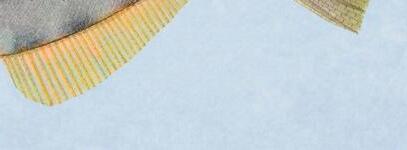















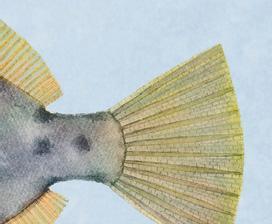









Most fish are sleek and streamlined, to swim through the water as quickly as possible, but leatherjackets have a different strategy. Instead of moving fast, they put their resources into defending themselves from attack: they are armoured with thick, leathery skin and have a sharp spike on the top of their head, like that of a unicorn. The spine is thrust up whenever the fish is alarmed, and locked into place by a second ‘trigger’ spine. Leatherjackets could never hope to chase down fast-moving prey, so instead they choose to eat prey that doesn’t move, such as sponges, sea squirts and barnacles. These are foods that no other fish in New Zealand eats, as they are full of spines and toxins. But leatherjackets make short work of them, chewing off morsels to eat with their strong, chisel-like teeth and powerful jaws.

Their tiny teeth can have a huge impact on the reef ecosystem. Leatherjackets act like underwater gardeners, slowly pruning the surface of the reef, bite by bite. Scientists estimate that where they are abundant, leatherjackets can modify up to twenty per cent of the rock face of a reef in a year. In reefs without leatherjackets, large sponges and sea squirts dominate, but when leatherjackets are present coralline algae and super-fastgrowing sponges are the main species. These sponges have developed a rapid growth rate to account for the onslaught of leatherjacket bites, and grow up to 20 times faster when being grazed.

European settlers in New Zealand were puzzled as to how such a ‘repulsive creature’ could produce such a beautiful shell.

(SeacologyNZ)

While female paper nautiluses have been known for thousands of years, the males were a complete mystery and were only discovered in the last century. Female paper nautiluses were sometimes found covered in strange worm-like creatures, and scientists suspected that these might be the males. The truth turned out to be even stranger, as they are in fact the male’s disembodied arms. The males never grow much larger than a peanut, and drift around the ocean without a shell. They have one larger arm that they tuck up in a pouch underneath their eye, and when they discover a female, they extend this arm and attach it to the female, using it to place sperm inside her. After mating, the arm is severed and the male soon dies, but the arm lives on, attached to the female.
Sometimes females are found with numerous male arms attached to them – one was recorded from Flinders Island in Australia with thirty-eight male arms inside her body and wrapped around her gills.5 The chance encounters between these male and female ocean wanderers are so unlikely that when they do meet a male is likely to sever his arm and attach it to the first female he meets.

Paper nautiluses live mostly in tropical and subtropical seas throughout the Indo-Pacific and spend their entire lives floating in the open ocean. They feed on molluscs, small fishes and crustaceans, and in turn are eaten by a range of creatures such as seabirds and fur seals. If their egg casings are damaged or lost they can grow new ones, secreting calcite from their webbed tentacles. While they are thought to be relatively common out at sea, it is rare to see them in the water or for their shells to be washed ashore intact.

Sightings of tiny juvenile paper nautiluses are very rare.



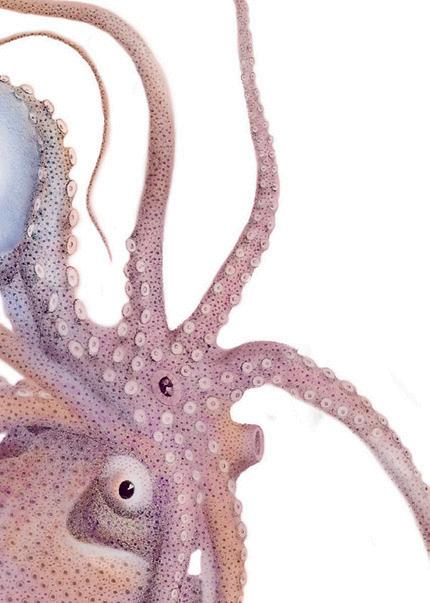


(SeacologyNZ)



















 Paper nautilus | Pūpū tarakihi
Paper nautilus | Pūpū tarakihi

Innovative and immensely topical, Te Motunui Epa is a triumph of storytelling and a challenge to the confines of traditional historiography. Rachel Buchanan’s meticulous research and compelling writing is complemented by the very best in graphic design –from its light-catching cover to the black-bordered array of archival documents. Generous while unafraid to confront the colonial hurt at the heart of the story, this is a deceptively powerful and enduring work.


So many verSionS of the paSt; it’s hard to carve a history out of it.
Ngāi Tahu weaver Cath Brown, one of the great Māori modernists, said: ‘When you do raranga, you weave things together. To make anything, you have to join pieces together to make it. Whereas with carving, you chip bits away. For me, it’s the complete antithesis. One is a joining together, and one’s a cutting away.’1
Writing history is like weaving but it is also like carving. You have to chip away at some of the enormous detail to reveal the shape of things, but you also need to gather together all the bits of the story that are scattered about in international law firms and chateaux in Geneva and lounge rooms in the backblocks of Taranaki. Sentence by sentence, words make a thread that can weave a cloak.
The kōrero loops back on itself, just like the carvings. Events can be understood from the vantage points of Geneva and London, with the wealth, power and prestige vested in institutions such as international auction houses and English courts, but these same events look quite different when viewed from the vantage point of New Plymouth. I was there then, aged ten, and Taranaki was the centre of my universe.
June 1978, sweet summertime in Europe. In London, Ortiz and Bleakley were counting down to auction day.
June 1978, bitter midwinter in Taranaki. Every fingertip turned blue and the bad weather crawled through the windows and into the house.
Patterns could be drawn on the ice that crusted the inside of the glass.
Torrential rain battered corrugated-iron roofs, found a chink in the shingles, pitter-pattered onto stairways, hallways, dining rooms, kitchens, pantries. Pots caught the drops and the music played all night long.
The hedgehog’s saucer of milk froze at the back door.
The two-bar heater: David versus Goliath.
A bucket of coal, a newspaper and a fireplace, the sound of an axe splitting kindling, the crackle of flames, a spectacle of warmth.
The word kapok. The smell of damp kapok. The faded flowers on the covers of the damp kapok duvets that had been procured in the auction at the pub when the pub shut so that it could be turned into a Cobb & Co. family restaurant.
Snow on the foothills. On the front lawn, a frost so thick it looked like snow.
The fog fell on the racecourse, and the phantom horses galloped by, spurred on by swear words and muffled whips.
There were corners of the gully that were dark all day.
The waves crashed over the breakwater at Ngāmotu and soaked my sisters and brothers and me. Moan the waves, as Dad liked to shout. At the St Joseph’s gala day, Pania’s dad, Wira, helped dig the hāngī. For six cents, a child could travel to the edge of town and back on the bus. A small blue ticket was all it took. The smell of wet wool skirts, netball tournaments in Stratford, the damp bibs and potato-topped pies, the way the cold marbled your skin, the sting of the supplejack that grew on the mountain, the weight of the bone-handled knife that Mum used to scrape the poo off the nappies, the weight of those wet nappies as I fed them through the wringer, the feeling of sitting on a branch at the top of a tree, the sound of Len Lye’s sculptures cutting through the Govett-Brewster Art Gallery –all those sensations from being ten in Taranaki in 1978 are tattooed into me, under the skin.
The personal and the political. The local and the national. The art and the not-art. The national treasure that was created in the time before the
nation. Taranaki! The intersections between all of these things. In 1978 when the Motunui Epa decided to show their faces again, our whānau’s whakapapa was still buried in the swamp.
Friday night, 2 June 1978. Graham Meads, owner of Inglewood TV and Radio, was up late watching television. He saw a filler from the BBC about an auction at Sotheby’s of treasures from Oceania. The camera lingered on the epa. The startled faces looked out at him from the screen. He heard the words Taranaki and Māori and masterpiece and art.2 That was the magic of telly. It brought the world into your lounge room. Kept you up to date.
On Sunday, Graham went to a party in New Plymouth. He bumped into Ron Lambert, the new director of the Taranaki Museum, and told him about the news item and the interesting fact that the carvings had been bought at an antique shop in America in 1935. Lambert was intrigued but also alarmed. The description rang a few bells. He had seen those carvings, or some very like them, in a photograph on Rigby Allan’s desk a few years before.
At work on Monday, Lambert started to hunt for the picture. On Tuesday, he found the photos that matched Graham Meads’s description and called John Yaldwyn at the National Museum. Yaldwyn had the Sotheby’s catalogue in front of him, and studied it as Lambert described the left-hand panel with its different style and the right-hand one with the square hole in it. Lambert thought of Melville Manukonga. He’d had quite a bit to do with him over the years and had given him access to museum collections for study purposes. It was common knowledge, locally, that Manukonga had found some panels. Could these be the ones?3
John Yaldwyn called Bob Cater, assistant secretary at the Department of Internal Affairs. As it turned out, Cater had also seen the television item about the auction, but thought nothing of it.
Arrangements were made to get photographs of the carvings – the ones taken for the Sotheby’s catalogue – to Cater and then up to Ron Lambert in New Plymouth. ‘John, Good things come to those who wait. Hope it’s not too late,’ says a handwritten note in the records. The signature is


indecipherable. Yaldwyn got the photos to Cater, and Cater dispatched them to Ron Lambert.4
Lambert called Cater to confirm that the two photos matched. Cater did a quick check to see if there was an export licence on file. None was forthcoming.
Bob Cater called the police in New Plymouth. On 7 June, the police had an informal chat with Ron Lambert and Melville Manukonga. Manukonga explained he had dug the carvings up and sold them. No, he could not remember the names of the buyers. Yes, he did have some photographs.
For the next three days, public servants at the Department of Internal Affairs hunted everywhere for an export licence for the pātaka. Still nothing.
Graham Meads, Ron Lambert, Bob Cater and John Yaldwyn had all picked up the wero, and others would soon follow.
12 June 1978. Bob Cater referred the matter to Allan Highet, Minister of Internal Affairs and MP for Remuera. Minister Highet spoke with his counterparts at Foreign Affairs and Crown Law.
13 June 1978. In the legal division of the Ministry of Foreign Affairs, John Gwilliam wrote a two-page memo to his colleague, Mr Mansfield. Title: ‘Proposed Auction of Maori Artefacts’ at Sotheby’s. Gwilliam said there appeared to be two courses of action to deal with the issue. One was diplomatic channels. The other was the British courts. The 1970 UNESCO Convention on the Means of Prohibiting and Preventing the Illicit Import, Export and Transfer of Ownership of Cultural Property was a bulwark of sorts, but neither New Zealand nor the United Kingdom had ratified it.5 Archaeologists, victim states and some museums had supported the convention; art collectors had either been indifferent or, like George Ortiz, hostile.6
16 June 1978. Wellington cabled London. Confidential. Urgent. It had been brought to the attention of the Ministry of Foreign Affairs that a rare Māori artefact was to be auctioned at Sotheby’s on 29 June. The government was eager to secure its return. The Ministry was considering whether any legal action could be brought so the artefact would be withdrawn from auction and then made subject for an action for return to the lawful owner, the New Zealand government.7
Jumping Sundays: The Rise and Fall of the Counterculture in Aotearoa New Zealand


Robin White: Something is Happening Here




Secrets of the Sea: The Story of New Zealand’s Native Sea Creatures
Te
Whakamihi to all the authors whose work has been recognised and honoured in this year’s Ockham New Zealand Book Awards. We urge you to seek out their titles in bookstores and libraries around the motu, and to join us to hear the finalists reading from their books, and to celebrate the ultimate winners, at the awards ceremony on Wednesday 17 May, during the Auckland Writers Festival. To find out more follow NewZealandBookAwards or #theockhams on Facebook and Instagram.
The Ockhams Samplers were compiled with the assistance of the Academy of New Zealand Literature.


Look out for the other category samplers at:
